Boogardie | |
|---|---|
 Interactive map of Boogardie | |
| Coordinates: 28°02′00″S117°47′00″E / 28.03333°S 117.78333°E | |
| Country | Australia |
| State | Western Australia |
| LGA | |
| Location |
|
| Established | 1898 |
| Government | |
| • State electorate | |
| • Federal division | |
| Population | |
| • Total | 0 (abandoned)[ citation needed ] |
Boogardie is an abandoned town in the Mid West region of Western Australia.
